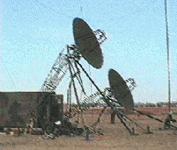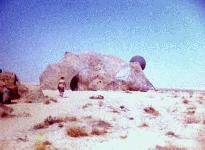


AN/TRC-170(V)2 Tropospheric Scatter Microwave Radio Terminal
Radio Terminal Sets AN/TRC 170 V2 and V3 are air or ground transportable troposcatter microwave radio
terminals. These terminals provide secure digital trunking between major nodes of a TRI TAC
communications network. The multichannel radio terminal interface with other TRI TAC and current
inventory equipment. TRC-170 terminals are also used in stand alone applications; that is, as a transmission
link not associated with a technical control. TRC-170 links might carry dedicated traffic to include analog and
digital channels, point to point subscriber circuits, facsimile circuits and teletype circuits.
The AN/TRC-170s are complete Tropospheric Scatter (TROPO) or Line Of Sight (LOS) terminals that include
antennas, radio transmitting and receiving equipment, and digital multiplexing equipment. Also included are
voice and data orderwire facilities. Built in test equipment (BITE) provides for fault reporting and confidence
testing of subsystems and major components. COMSEC equipment is supplied for encryption of mission and
orderwire traffic. A source of primary power is not included in either terminal set.
The most significant difference between the V2 and V3 terminals sets are:
- Size and Weight (V3 is smaller and lighter).
- Nominal transmission range (150 miles for V2, 100 miles for V3).
- Setup and tear down times (V3 can be set up and torn down more rapidly by fewer technicians).
- RF Sections ( The most significant difference is the V2 uses quad diversity and the V3 uses dual diversity).
Both terminals pass traffic in a full duplex mode and enhance transmission quality by using two antennas
and two receivers to provide space diversity reception. In addition to the space diversity feature, the V2
terminal uses a second power amplifier and two additional receivers to accomplish frequency and/or
polarization diversity. For frequency diversity the two power amplifiers operate on separate frequencies
within the 4.4 to 5.0 GHz microwave frequency band. The two additional receivers, again operating in a space
diversity configuration, are tuned to the second transmitting frequency of the remote terminal. For
Polarization Diversity one transmitter is sent Vertically Polarized and the other is sent Horizontally Polarized.
Both transmitters are sending the same frequency but they are sent with a different relationship to earth
(Vertical & Horizontal). Two receivers would receive the Horizontal signal and two receivers would receive
the Vertical signal. In this manner, space and frequency or space and polarization known as quadruple (quad)
diversity is accomplished in the V2 terminal. This quad diversity produces a lower bit error rate (BER) which
contributes to achievement of greater nominal range for the V2 terminal. The BER is a measure of data errors
received. The Tropo Modem Demodulator calculates the BER and reports the number to the CNCE.
The AN/TRC-170(V)2 is a digital
tropospheric scatter radio terminal which provides
connectivity between two major nodes. The
AN/TRC-170(V)2 can operate in either dual space or quad
frequency diversity. The radio can be configured in either Line-of-Sight (LOS) or
tropospheric scatter modes of propagation. Radio Frequency (RF) operation for both
transmit and receive is in the 4.4 to 5.0 GHz frequency range with 3.5 or 7.0 MHz
selectable bandwidth (3.5 MHz mode is used in Europe). The transmitted data rate of
the AN/TRC-170(V) can be at any TRI-TAC standard rate from 128 KB/s to 4608
KB/s (The actual "mission" rate will be slightly higher, this includes overhead,
orderwires).
The AN/TRC-170(V) is capable of providing connectivity to a mixture of up to 32
analog (includes FSK), or digital, local subscriber channels and up to 4 TRI-TAC Digital
Trunk Groups (DTG). A single TRI-TAC group consisting of up to 144 subscriber loops
(2304 KB/s or 4608 KB/s) can be configured to operate using external equipment vans
to provide the high data rate DTG.
The AN/TRC-170(V) operates only in a point-to-point mode of operation. The primary
purpose of the AN/TRC-170(V) is to provide connectivity between two major TRI-TAC
nodes. The AN/TRC-170(V) can remote the two nodes by approximately 100 to 150
miles. This is entirely dependent on the AN/TRC-170 version, antenna type, RF path
profile, which must be calculated using the Site Analysis Tools software written by
MITRE or an equivalent software program. Parameters such as path length, path profile
(hills, mountains, obstacles), mission data rate, transmit power, receive diversity, and
atmospheric conditions will affect the length of the supported mission. NOTE: As
mission data rate goes higher, supportable path distance goes down. The
AN/TRC-170(V) can extend the normal path lengths by using radio relays. Eight radio
links can be relayed together to extend the path distances, or around obstacles.


Sources and Resources
http://www.fas.org/man/dod-101/sys/ac/equip/an-trc-170.htm
Maintained by Robert Sherman
Originally created by John Pike
Updated Saturday, January 09, 1999 10:27:01 AM






